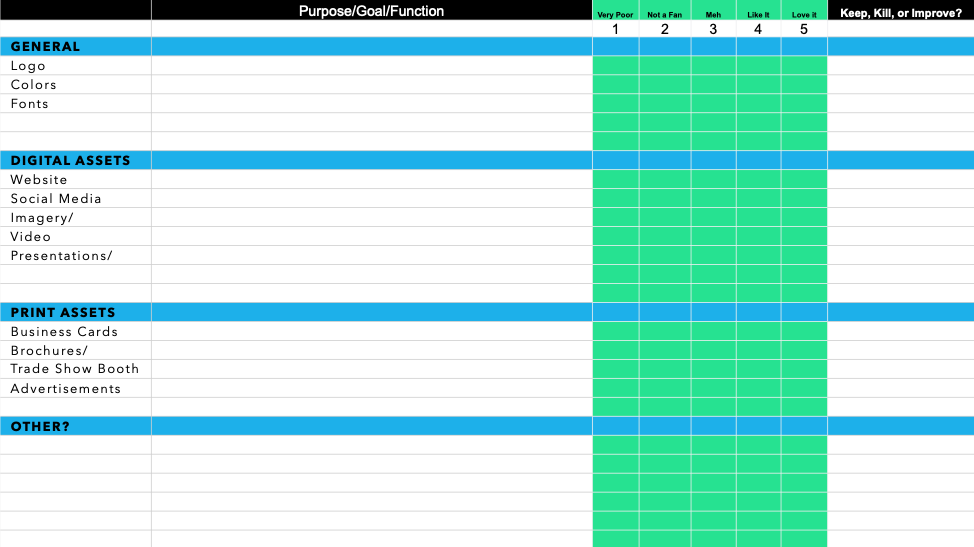The Importance of a Visual Identity Audit
The Importance of a Visual Identity Audit
In the first part of the Purposeful Marketing Method’s Brand Day, teams work on their messaging when developing a Communication Strategy. Naturally, the next step is to answer the question “does your current visual identity align with the new brand positioning in your Communication Strategy?”
Let’s take a look at the assessment below and find out!

We segment the visuals by General, Digital, Print, and leave space for. Additionally, we leave two spaces in each segment for you to place collateral that’s specific to your business. If you have more than this, by all means, do what you need to do to customize the assessment to your needs. Cross things out, add rows, whatever you need to do. Here’s a digital version that’s easy to adjust.
Once you customize your “A” column to fit your needs, the next thing to consider is the why behind each element. Remember, we need to examine the WHY of everything we’re doing. If we know why we’re doing it, it will direct what and how we do it accordingly. So once the variables on the left are decided upon, you need to explain their purpose, goal, or function. If you can’t really identify it, then that’s going to be a problem.
Before you begin grading each piece, one thing to emphasize is pragmaticism. If you want to grade your current creative on a strict scale and give your collateral a lot of 1s and 2s, you’re saying these items need to be reconfigured to fit your new identity. On the flip side, if you throw a bunch of 4s and 5s around because you like your current style, make sure the style is matching the purpose.
With that in mind, go through and grade your current look and feel as a team. If everyone submits an individual assessment, chances are, consensus will take hours for the entire team to find if they ever get there. Understand that there will probably be differences and choose one of two options to get through the disagreements:
1) put someone in charge of being the deciding voice when those differences come to fruition.
2) Go around the room and have everyone say their number and take the average, rounding up and down as needed.
We Just Finished the Assessment – Now What?
Chances are, your results can be summarized in one of three ways:
- We love our visual branding, it looks great! Fantastic news! If you’re on solid footing with your visual identity and it reflects the communication strategy we built before, you’re ahead of the game!
- There’s elements we really like, but some things need work. Fear not, you are just like 80% of businesses that take this assessment. Knowing that you have an aspect of your visual communications you think is effective and represents the image you are trying to convey gives you a great starting point.
Your next step is to identify your 1s and 2s. What are the next steps with each? What needs to be updated? What needs to simply be eliminated from your collateral altogether? For everything that needs to be reconfigured, put the tasks on your Obstacles list.
Now go through your 3s. What stays? What needs to go? Just like before, if you need to have one person make the call or take a vote to come to a decision, go for it. Put the 3s you want to re-work on the Obstacles list.
- Um, our creative is awful and everything needs to be overhauled. Take a deep breath, it’s going to be alright. You took the assessment to get everything aligned and defined and you’re going to leave this exercise knowing what to do and in what order it needs to be done.
If we’re starting from scratch, we need to move on to the Style Discovery Guide. Go back start with the basics: Colors, Fonts, Logos. We will build the brand identity with those elements first. From there, digital and print collateral will be added based on need, which we will figure out once we have identified all of the upcoming Obstacles list.
The Visual Identity Assessment is where the culmination of the mental breakthroughs you’ve experienced to this point turn to action. The VIA is where the decisions are made. The team should feel confident that these are the right decisions since their Communication Strategy is freshly defined. If you can say what you are, you can start showing it too.



